In the bustling world of culinary creations, where the sizzle of pans harmonizes with the aroma of delectable dishes, one indispensable tool reigns supreme: the non-stick pan.
A culinary companion cherished by home cooks and professional chefs alike, its smooth surface promises effortless flips, flawless omelets, and minimal scrubbing. Yet, beneath the glossy facade lies a question that lingers in the minds of many: How long does this kitchen marvel truly last?
Like a well-guarded secret whispered among kitchen cabinets, the lifespan of non-stick pans dances between myth and reality, tantalizing our curiosity with every sizzle and slide.
Join us as we embark on a journey through the sizzling landscapes of culinary durability, unraveling the mysteries that cloak the longevity of these essential kitchen companions.

How Long Do Non Stick Pans Last
Non-stick pans typically last between one to five years, depending on usage and care.
Understanding Non-Stick Pan Lifespan
Non-stick pans, cherished for their convenience, have a varying lifespan determined by several factors. Regular use, cooking techniques, and maintenance habits all contribute to their longevity. Understanding these aspects can help prolong the life of your non-stick cookware.
Usage Frequency and Cooking Techniques
Frequent use and high-heat cooking can expedite the wear and tear of non-stick coatings. Using metal utensils or abrasive cleaners can also degrade the non-stick surface more quickly. Opting for lower heat settings and silicone or wooden utensils can extend the lifespan of your pans.
Quality of Non-Stick Coating
The quality of the non-stick coating significantly impacts the pan’s durability. Higher-quality coatings, such as ceramic or titanium-infused, tend to last longer than traditional coatings. Investing in a reputable brand known for durable non-stick cookware can be worthwhile in the long run.
Proper Maintenance and Care
Proper maintenance plays a crucial role in preserving non-stick pans. Handwashing with mild detergent and avoiding harsh scrubbing can prevent scratches and preserve the non-stick surface. Storing pans properly, such as stacking them with protective layers in between, can also prevent damage.
Signs of Wear and Replacement
Despite diligent care, non-stick pans eventually show signs of wear, such as peeling or flaking coatings. When these signs become apparent, it’s time to consider replacing the pan. Continuing to use pans with degraded coatings can compromise food quality and safety.
Tips On Caring For Your Non-Stick Pan
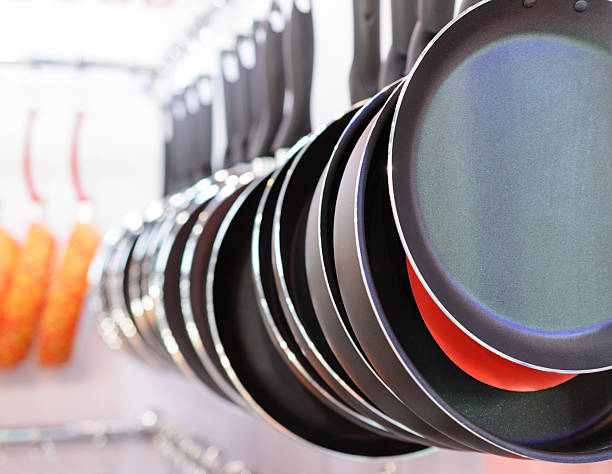
Caring for your non-stick pan is essential to ensure its longevity and effectiveness in cooking. Here’s a detailed explanation of each step:
Pre-use Preparation
Pre-use preparation is a crucial step in caring for your non-stick pan to ensure optimal performance and longevity. Before using your non-stick pan for the first time, it’s essential to wash it thoroughly with warm, soapy water and rinse it well.
This initial cleaning removes any manufacturing residues, dust, or contaminants that may be present on the surface, ensuring a clean cooking surface for your food. This step helps to eliminate any potential odors or tastes that could transfer to your food during cooking.
Once washed, dry the pan completely with a clean cloth or towel before seasoning, if necessary, or proceeding with your cooking. Taking the time for pre-use preparation sets the foundation for a successful cooking experience with your non-stick pan and contributes to its overall maintenance and performance over time.
Seasoning (Optional)
Seasoning a non-stick pan is an optional but beneficial step that can help enhance its non-stick properties and improve its performance over time, particularly for pans made of materials like cast iron or carbon steel.
To season a non-stick pan, start by thoroughly cleaning and drying it. Next, apply a thin layer of cooking oil or fat to the cooking surface, using a paper towel or cloth to spread it evenly across the entire interior of the pan, including the sides.
Common oils used for seasoning include vegetable oil, canola oil, or flaxseed oil. Once the oil is evenly distributed, place the pan in a preheated oven at a temperature specified by the manufacturer, typically around 350°F to 400°F (175°C to 200°C).
Let the pan bake for about an hour, allowing the oil to polymerize and form a natural non-stick coating on the surface. After seasoning, allow the pan to cool completely before wiping away any excess oil with a clean cloth.
Repeat the seasoning process as needed, especially after washing the pan, to maintain its non-stick properties and improve its performance over time. While seasoning is optional, it can contribute to a smoother cooking surface, reduce food sticking, and prolong the lifespan of your non-stick pan.
Use the Right Utensils
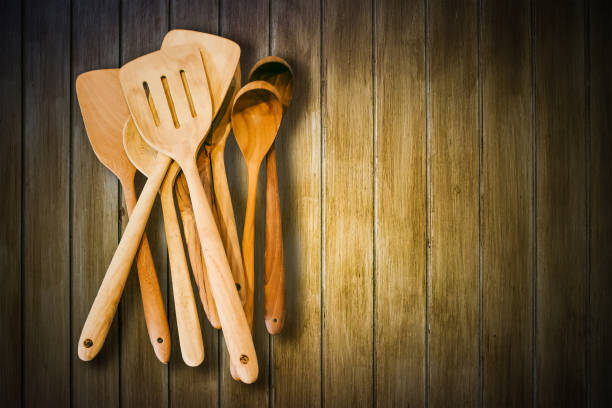
Using the right utensils is essential for maintaining the integrity of your non-stick pan’s coating and preventing damage during cooking. Opt for non-metallic utensils such as silicone, nylon, or wooden spoons and spatulas when cooking with non-stick pans.
These materials are gentle on the pan’s surface and help prevent scratching or chipping of the non-stick coating, which can degrade its effectiveness over time. Avoid using metal utensils like stainless steel or aluminum, as they can easily scratch the non-stick surface, compromising its ability to release food smoothly and evenly.
Using non-metallic utensils helps to prolong the lifespan of your non-stick pan, ensuring that it remains a reliable tool in your kitchen for years to come.
By choosing the right utensils, you can protect your non-stick pan and enjoy hassle-free cooking without worrying about damaging its coating.
Avoid High Heat
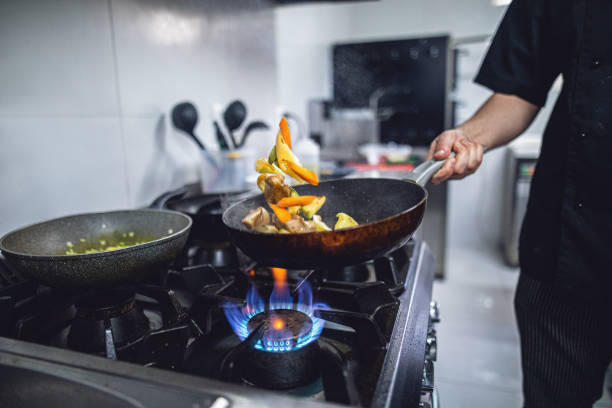
Avoiding high heat is crucial for maintaining the quality and longevity of your non-stick pan. Non-stick coatings are designed to withstand moderate temperatures, but exposing them to high heat can cause the coating to degrade over time.
When cooking with a non-stick pan, it’s best to use low to medium heat settings on your stove. This ensures that the pan heats evenly without reaching temperatures that could potentially damage the non-stick surface.
High heat can also cause food to cook too quickly, increasing the risk of burning or sticking to the pan, which can further degrade the coating.
By using gentle heat settings, you not only protect the non-stick coating but also ensure that your food cooks evenly and without sticking, resulting in better cooking results and easier cleanup.
Use Oil or Fat
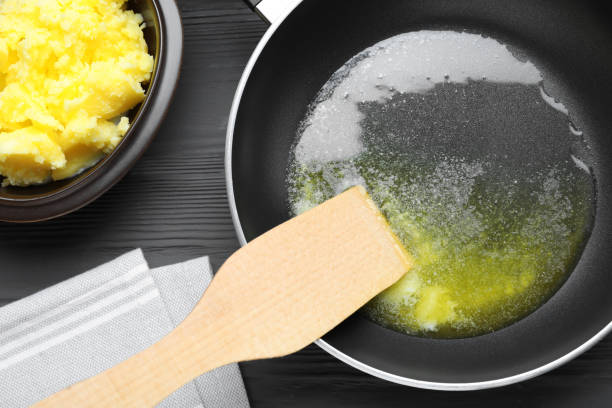
Using oil or fat when cooking with a non-stick pan is an important step to enhance the cooking process and prevent food from sticking. While non-stick pans require less oil or fat compared to traditional pans, a small amount can still be beneficial.
Adding oil or fat helps to create a barrier between the food and the pan’s surface, reducing the likelihood of sticking and ensuring even cooking. When choosing an oil or fat, opt for those with high smoke points, such as canola, vegetable, or peanut oil.
These oils can withstand the heat typically used for cooking without burning or smoking excessively, which can negatively affect the flavor of your food. To use oil or fat with a non-stick pan, simply add a small amount to the pan before cooking and spread it evenly across the surface using a brush or spatula.
This thin layer of oil helps to lubricate the pan and facilitates the release of food, resulting in easier cooking and cleanup. By incorporating oil or fat into your cooking process, you can maximize the performance of your non-stick pan and ensure delicious, evenly cooked meals every time.
Hand Washing
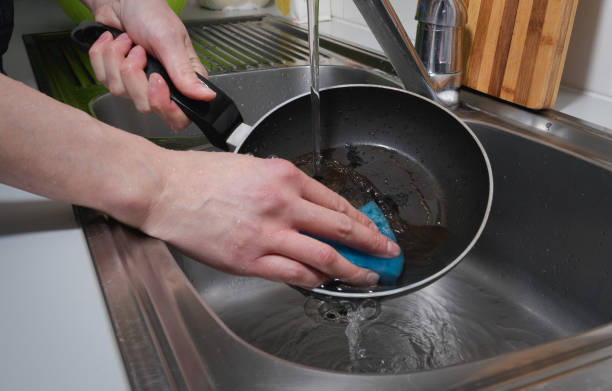
Hand washing your non-stick pan is a crucial step in its care routine to maintain its non-stick properties and extend its lifespan. Non-stick pans are typically not dishwasher safe, so hand washing is the preferred method to avoid damaging the delicate non-stick coating.
To hand wash your non-stick pan, start by allowing it to cool down after use to prevent warping or damage. Then, use a soft sponge or cloth and mild dish soap to gently scrub the interior and exterior of the pan.
Avoid using abrasive scrubbers or harsh chemicals, as they can scratch or wear down the non-stick coating. Pay extra attention to any stubborn food residue, using a non-abrasive sponge or nylon brush if necessary.
Rinse the pan thoroughly with warm water to remove any soap residue. Finally, dry the pan completely with a soft towel or allow it to air dry before storing to prevent water spots or damage.
By hand washing your non-stick pan with care, you can ensure that it remains in pristine condition and continues to provide reliable performance for your cooking needs.
Avoid Abrasive Cleaners
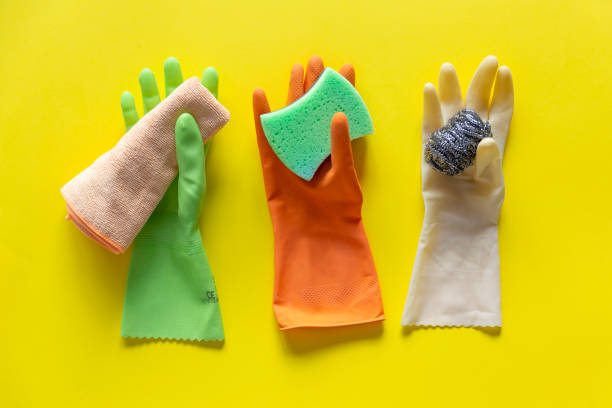
Avoiding abrasive cleaners is paramount when caring for your non-stick pan to preserve its coating and maintain its effectiveness. Abrasive cleaners, including scouring pads and harsh chemicals, can cause irreversible damage to the non-stick surface, leading to reduced performance and a shorter lifespan for your pan.
These abrasive materials can scratch or wear down the non-stick coating, creating rough spots where food can easily stick and burn. Instead of abrasive cleaners, opt for mild dish soap and a soft sponge or cloth when washing your non-stick pan by hand.
Gently scrub the surface to remove any food residue without causing damage. If you encounter stubborn stains or buildup, consider soaking the pan in warm, soapy water to loosen them before gently scrubbing.
By avoiding abrasive cleaners and opting for gentle cleaning methods, you can prolong the life of your non-stick pan and ensure it continues to provide reliable performance for all your cooking needs.
Store Properly
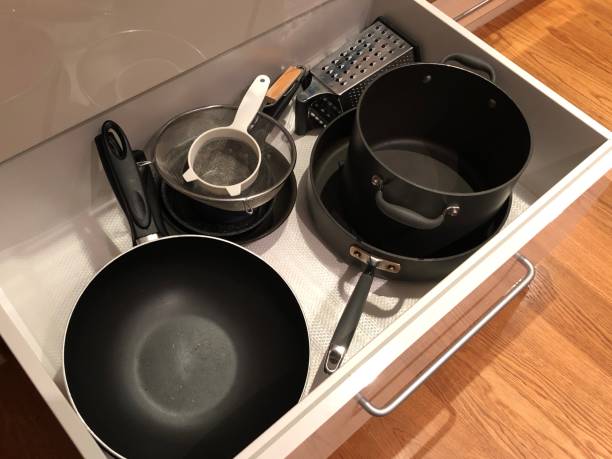
Proper storage is essential for maintaining the condition and effectiveness of your non-stick pan. Storing it correctly helps prevent scratches, dents, and other damage that can compromise its non-stick coating.
When storing your non-stick pan, ensure it is completely dry to prevent the growth of mold or mildew. Avoid stacking heavy items on top of the pan, as this can cause warping or deformation.
Instead, consider placing a soft cloth or paper towel between stacked pans to provide cushioning and prevent scratches. If you have limited storage space, hanging your non-stick pans on a pot rack or wall-mounted hooks can be a convenient and space-saving option.
When storing in cabinets or drawers, make sure there is enough space to avoid overcrowding, which can lead to scratches or damage from shifting. By storing your non-stick pan properly, you can preserve its quality and extend its lifespan, ensuring it remains a reliable tool in your kitchen for years to come.
Regular Inspection
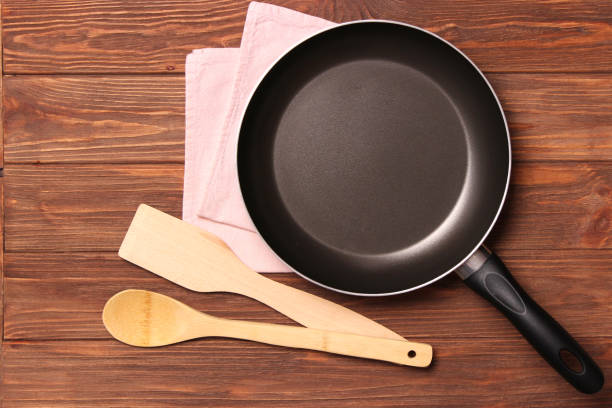
Regular inspection of your non-stick pan is essential for identifying any signs of wear or damage to the coating, allowing you to address issues promptly and maintain its performance.
Set a schedule to inspect your non-stick pan periodically, ideally after each use or at least once a month, depending on your frequency of use. During inspection, closely examine the interior cooking surface for any scratches, chips, or areas where the coating may be wearing off.
Pay attention to any changes in the appearance or texture of the coating, as well as any unusual smells or tastes that may indicate deterioration. If you notice any signs of damage, it’s essential to address them promptly to prevent further deterioration and maintain food safety.
Depending on the severity of the damage, you may need to discontinue use of the pan and consider replacing it to ensure optimal performance and safety.
By conducting regular inspections, you can proactively identify and address any issues with your non-stick pan, helping to prolong its lifespan and ensure it continues to provide reliable performance for your cooking needs.
Cooking Sprays
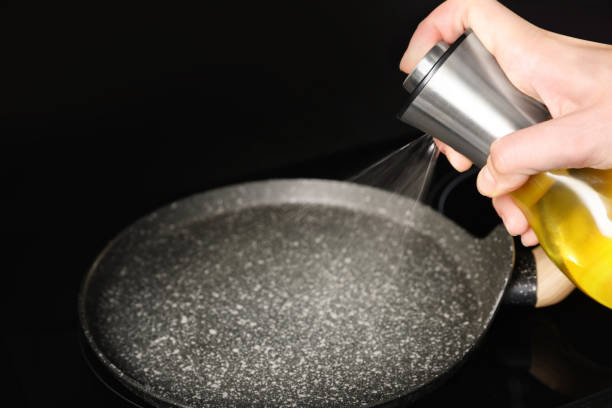
Cooking sprays are a popular option for adding a thin layer of oil or fat to cooking surfaces, including non-stick pans. They are convenient and easy to use, often providing a quick and even distribution of oil without the need for additional utensils. However, when using cooking sprays with non-stick pans, it’s essential to exercise caution.
Firstly, choose a cooking spray specifically formulated for non-stick surfaces. These sprays typically contain ingredients that are less likely to build up on the pan’s surface, which can lead to a sticky residue over time.
Secondly, use cooking sprays sparingly. While they can help prevent food from sticking, excessive use may lead to a buildup of residue on the pan’s surface, potentially diminishing its non-stick properties.
Additionally, be mindful of the propellants used in cooking sprays, as some may leave behind a residue that can affect the flavor of your food or cause the pan’s surface to become tacky.
To use cooking sprays effectively with non-stick pans, hold the spray canister a few inches away from the pan and apply a light, even coating. Avoid spraying directly over high heat, as this can cause the spray to burn and leave behind a sticky residue.
Overall, while cooking sprays can be a convenient option for adding oil to non-stick pans, it’s essential to use them judiciously and choose products specifically designed for use with non-stick surfaces to avoid compromising the performance and longevity of your pan.
The Tell-Tale Signs You Need To Replace Your Non-Stick Pan
Knowing when to replace your non-stick pan is essential for maintaining both its performance and your safety in the kitchen. Here are some tell-tale signs indicating it’s time for a replacement:
Scratches
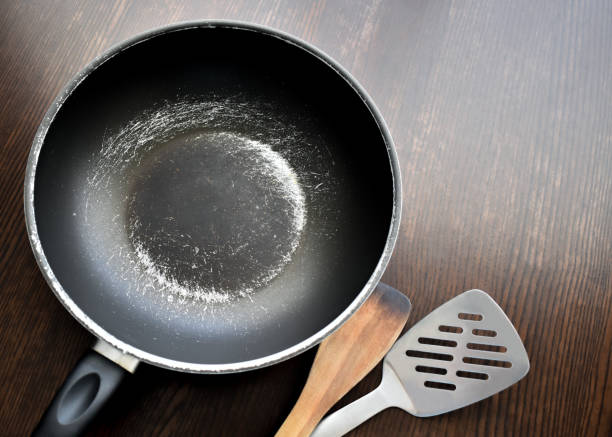
Scratches on a non-stick pan’s surface can signal potential issues and compromise its effectiveness in the kitchen. When scratches appear, they create rough areas where food particles can easily become trapped, leading to uneven cooking and increased likelihood of food sticking to the pan.
Moreover, scratches may expose the underlying metal, which can react with acidic or alkaline foods, altering their flavor and potentially posing health risks. Continued use of a scratched non-stick pan can accelerate the deterioration of the coating, leading to further damage and reducing its lifespan.
Therefore, it’s essential to handle non-stick pans with care, avoiding metal utensils and abrasive cleaning tools that can cause scratches. Regular inspection for signs of scratching and prompt replacement when necessary can help maintain the integrity of your non-stick pans and ensure safe and efficient cooking experiences.
Chipping, Flaking, Peeling
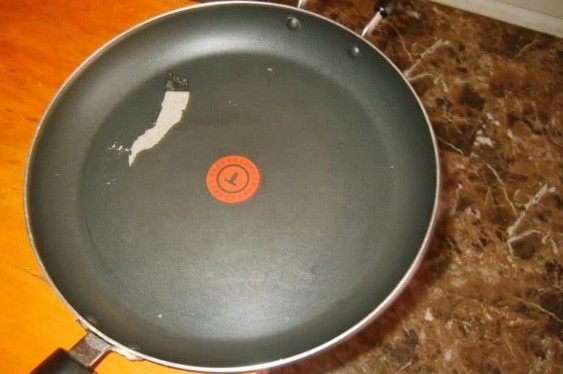
Chipping, flaking, or peeling of the non-stick coating on a pan is a clear indication of significant wear and deterioration, necessitating immediate attention.
These signs typically arise from the breakdown of the coating due to factors such as high heat exposure, abrasive cleaning methods, or the use of metal utensils. When the coating begins to chip, flake, or peel, it not only compromises the pan’s non-stick properties but also raises concerns about potential ingestion of harmful chemicals or particles from the coating.
Cooking with a pan showing such signs can result in uneven heating, food sticking, and contamination of your meals. Therefore, it is crucial to replace a non-stick pan exhibiting chipping, flaking, or peeling to ensure both optimal cooking performance and food safety.
Regularly inspecting your pans for these signs and handling them with care can help prolong their lifespan and maintain their quality in the kitchen.
Sticking
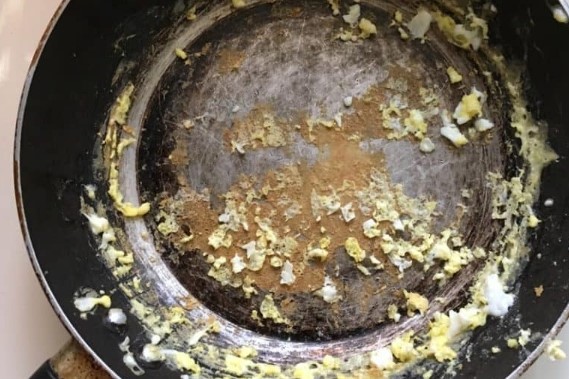
Sticking of food to a non-stick pan’s surface is a common issue that can indicate various underlying problems. While non-stick pans are designed to prevent food from adhering to the surface, several factors can contribute to sticking.
Over time, wear and tear, such as scratches or abrasions on the pan’s coating, can compromise its non-stick properties, leading to increased instances of food sticking. Additionally, improper seasoning, excessive heat, or the use of metal utensils can damage the coating, making it more prone to sticking.
It’s crucial to address sticking issues promptly by assessing the condition of the pan, adjusting cooking techniques, and considering replacement if necessary. Proper care, such as hand washing with mild detergent and avoiding abrasive cleaning methods, can help maintain the integrity of the non-stick coating and reduce the likelihood of sticking.
Regularly inspecting the pan for signs of wear and adhering to recommended cooking temperatures and utensils can also contribute to a smoother cooking experience with minimal sticking.
Tips When Buying Non-Stick Pans
When purchasing non-stick pans, there are several essential tips to consider to ensure you select the right one for your needs:
1. Material and Construction
When considering non-stick pans, it’s crucial to pay close attention to the material and construction of the cookware. Non-stick pans are available in various materials, each with its own set of benefits.
Aluminum pans are lightweight and excellent heat conductors, while stainless steel offers durability and resistance to corrosion. Ceramic pans provide a non-toxic alternative with excellent non-stick properties, and hard-anodized aluminum pans are known for their exceptional durability and scratch resistance.
Regardless of the material, prioritize pans with sturdy construction and even heat distribution for consistent cooking results. By selecting the right material and construction, you can ensure that your non-stick pan meets your cooking needs and withstands the test of time in your kitchen.
2. Coating Quality
When purchasing a non-stick pan, one of the most critical factors to consider is the quality of the coating. The coating is what provides the non-stick properties to the pan’s surface, allowing for easy food release and effortless cleaning.
Look for pans with high-quality coatings that are PFOA-free and free from other harmful chemicals. Opt for coatings that are durable, scratch-resistant, and designed to withstand high temperatures without deteriorating.
Consider the thickness of the coating, as thicker coatings tend to be more durable and longer-lasting. Choosing a non-stick pan with a high-quality coating ensures that you’ll enjoy reliable non-stick performance and safe cooking for years to come.
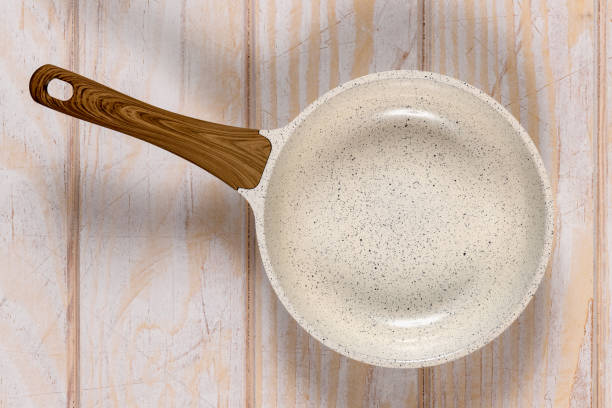
3. Size and Shape
When purchasing a non-stick pan, carefully consider the size and shape to ensure it meets your cooking needs. The size of the pan should be suitable for the quantity of food you typically cook, with enough capacity to accommodate your recipes comfortably.
Consider the number of servings you usually prepare and whether you need a smaller skillet for individual meals or a larger sauté pan for family dinners. Think about the shape of the pan and how it will fit on your stove or in your oven.
Choose a shape that suits the type of dishes you frequently cook, whether it’s a shallow skillet for quick stir-fries or a deeper saucepan for simmering sauces and soups. By selecting the right size and shape, you can ensure that your non-stick pan is versatile and convenient for a variety of cooking tasks.
4. Handle Comfort and Stability
When purchasing a non-stick pan, it’s essential to consider the handle’s comfort and stability. The handle is a crucial aspect of the pan’s design, as it affects your ability to maneuver and control the cookware safely.
Look for a handle that feels comfortable and ergonomic in your hand, with a design that allows for a secure grip during cooking. Ensure that the handle stays cool to the touch during stovetop use, reducing the risk of burns or accidents.
Check that the handle is securely attached to the pan, with no wobbling or instability. A stable handle provides confidence and control while cooking, enhancing your overall cooking experience with the non-stick pan.
5. Compatibility
When selecting a non-stick pan, it’s crucial to consider its compatibility with your cooktop. Different cooktops require specific types of pans to ensure optimal performance and safety.
For example, induction cooktops require pans with a magnetic base, while gas and electric cooktops can accommodate a wider range of pans. Verify that the non-stick pan you choose is compatible with your cooktop type to prevent any issues with heating efficiency or damage to the cookware.
Consider factors such as oven compatibility if you plan to use the pan for baking or finishing dishes in the oven. By ensuring compatibility, you can enjoy seamless cooking experiences with your non-stick pan across various cooking surfaces.
6. Price and Value
When purchasing a non-stick pan, it’s essential to consider both the price and the value it offers. While price is a factor, focusing solely on the initial cost may overlook long-term benefits and durability.
Consider the value the pan provides in terms of its construction quality, durability, and performance. Investing in a higher-priced pan made from quality materials with a durable non-stick coating may offer better value in the long run, as it can withstand frequent use and last for years.
Consider factors such as warranty coverage and customer reviews to assess the overall value of the pan. By weighing both the price and the value it offers, you can make an informed decision and choose a non-stick pan that meets your cooking needs while providing long-lasting performance and durability.
7. Warranty and Customer Reviews
When purchasing a non-stick pan, it’s essential to consider both the warranty offered by the manufacturer and customer reviews. A warranty can provide peace of mind and protection against defects in materials or workmanship.
Check the length and coverage of the warranty to ensure it aligns with your expectations and needs. Reading customer reviews can offer valuable insights into the pan’s performance, durability, and overall satisfaction among users.
Pay attention to common themes or issues mentioned in reviews to gauge the pan’s reliability and suitability for your cooking requirements. By considering both the warranty and customer reviews, you can make a more informed decision and choose a non-stick pan that meets your expectations and delivers excellent results in the kitchen.

Frequently Asked Questions (FAQs) – How Long Do Non Stick Pans Last
What is the typical lifespan of a non-stick pan?
Non-stick pans can last anywhere from 3 to 5 years with proper care and usage. However, some high-quality brands may even last longer, providing reliable performance for many years.
How can I extend the lifespan of my non-stick pan?
You can extend the lifespan of your non-stick pan by avoiding metal utensils, using gentle cleaning methods, and storing it properly. Additionally, seasoning your pan occasionally can help maintain its non-stick properties.
Are there any signs that indicate it’s time to replace my non-stick pan?
Yes, when the non-stick coating starts to peel, chip, or show signs of wear, it’s a good indication that it’s time to replace your pan. However, with proper care, you can delay this and enjoy your pan for longer.
What are the benefits of investing in a high-quality non-stick pan?
High-quality non-stick pans are often more durable and have better heat distribution, leading to more even cooking. They also tend to have stronger non-stick coatings that last longer, providing better value for your investment.
Can I use non-stick pans on high heat?
While non-stick pans are generally safe for low to medium heat cooking, it’s best to avoid using them on high heat settings to prevent damage to the non-stick coating. Using them within their recommended temperature range can help prolong their lifespan.
How do I clean my non-stick pan to ensure longevity?
To clean your non-stick pan, use mild dish soap, a soft sponge or cloth, and avoid abrasive cleaners or scrubbers. Gentle hand washing and thorough drying after each use can help preserve the non-stick coating and extend the pan’s lifespan.
Are there any cooking practices that can help preserve my non-stick pan?
Yes, using cooking oils or butter sparingly can help prevent food from sticking to the pan and reduce the likelihood of scratches or damage to the non-stick coating. Additionally, avoid cooking acidic foods for prolonged periods as they can degrade the coating over time.
What makes non-stick pans a convenient option for everyday cooking?
Non-stick pans offer the convenience of easy food release and quick cleanup, making them ideal for busy households. Their versatility and ability to cook with less oil also contribute to their popularity among home cooks.
Conclusion
In conclusion, the lifespan of non-stick pans can vary significantly depending on various factors such as usage frequency, maintenance practices, and quality of the pan.
While some non-stick pans may last for several years with proper care, others may lose their effectiveness much sooner. It is crucial to follow manufacturer’s instructions for use and care to prolong the lifespan of these kitchen essentials.
Investing in higher quality non-stick pans and being mindful of utensils and cooking methods can contribute to their longevity. Ultimately, understanding the signs of wear and tear and knowing when it’s time to replace a non-stick pan is essential for maintaining a safe and efficient cooking experience.